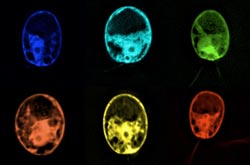UC San Diego Biologists Produce Rainbow-Colored Algae

Photo credit: Beth Rasala, UC San Diego<br>
That’s the question biologists at UC San Diego sought to answer when they engineered a green alga used commonly in laboratories, Chlamydomonas reinhardtii, into a rainbow of different colors by producing six different colored fluorescent proteins in the algae cells.
While fluorescent green, red, blue and yellow may be all the rage this year for running shoes and other kinds of sporting gear, fluorescent algae hasn’t been a style trend yet in scientific laboratories. But in announcing their achievement in the current issue of The Plant Journal, the UC San Diego biologists said tagging algae with different kinds of fluorescent proteins would provide an important laboratory tool for algae researchers.
It could be used to sort different kinds of cells, allow scientists to view cellular structures like the cytoskeleton and flagella, or even to create “fusion proteins,” allowing scientists to follow a protein around the cell.
Although rainbow colored algae are not likely to end up in a store near you any time soon, the scientists say they are powerful tools that will allow biologists working on algae to make biotechnology developments more rapidly, ultimately leading to the production of lower-cost biofuels and cheaper human and animal therapeutics. Several months ago, biologists in the same UC San Diego laboratory reported genetically engineering Chlamydomonas algae to produce a complex and expensive human therapeutic drug used to treat cancer.
The rainbow-colored algae were developed by a collaboration that included scientists from the University of Nebraska, Lincoln. Beth Rasala, a postdoctoral fellow in Mayfield’s laboratory, is the lead author of The Plant Journal paper. The research was funded by the U.S. Department of Energy and the California Energy Commission.
Media Contact
Kim McDonald, 858-534-7572, kmcdonald@ucsd.edu
Media Contact
More Information:
http://www.ucsd.eduAll latest news from the category: Life Sciences and Chemistry
Articles and reports from the Life Sciences and chemistry area deal with applied and basic research into modern biology, chemistry and human medicine.
Valuable information can be found on a range of life sciences fields including bacteriology, biochemistry, bionics, bioinformatics, biophysics, biotechnology, genetics, geobotany, human biology, marine biology, microbiology, molecular biology, cellular biology, zoology, bioinorganic chemistry, microchemistry and environmental chemistry.
Newest articles

Superradiant atoms could push the boundaries of how precisely time can be measured
Superradiant atoms can help us measure time more precisely than ever. In a new study, researchers from the University of Copenhagen present a new method for measuring the time interval,…

Ion thermoelectric conversion devices for near room temperature
The electrode sheet of the thermoelectric device consists of ionic hydrogel, which is sandwiched between the electrodes to form, and the Prussian blue on the electrode undergoes a redox reaction…

Zap Energy achieves 37-million-degree temperatures in a compact device
New publication reports record electron temperatures for a small-scale, sheared-flow-stabilized Z-pinch fusion device. In the nine decades since humans first produced fusion reactions, only a few fusion technologies have demonstrated…





















